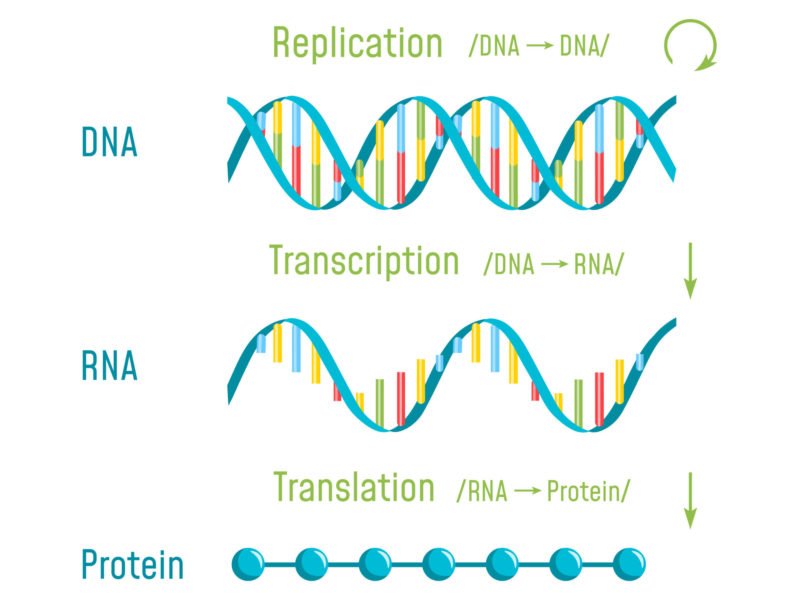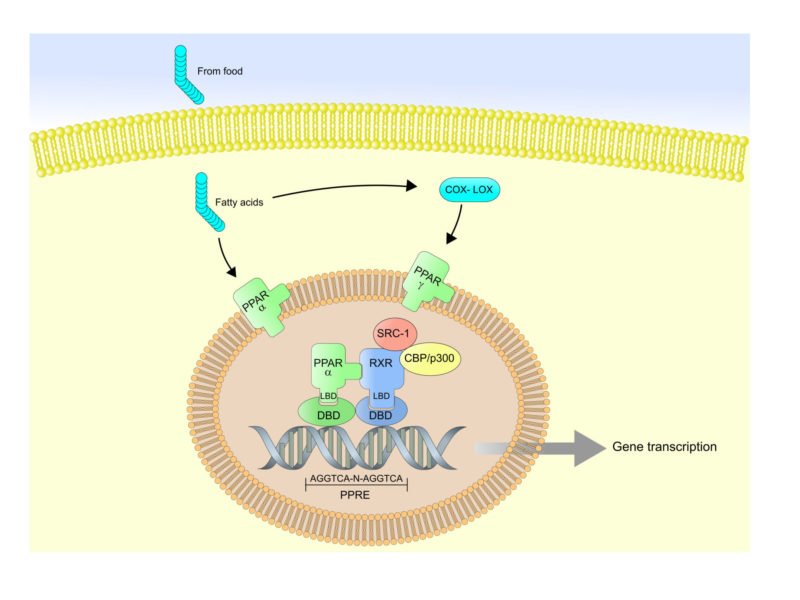Gene Regulation by Nutrition
The nutrients we consume can impact gene expression and the way our genes are regulated. Gene expression can be altered by the environment of a cell. Environmental factors include lifestyle choices and nutrition. Nutrition can modify the cellular processes inside our body for better or worse. Not only can nutrients and vitamins lessen the severity of disease, but they can help scientists establish more targeted treatment plans. By further understanding the gene regulation process and what affects it, we’re able to better understand diseases.
What is Gene Expression?
Gene expression describes the process where information stored in our genes becomes a protein or other functional unit (1). Gene expression in a cell can change based on the surrounding environment. It can control when proteins are produced and the quantity made. Gene expression happens through processes called transcription and translation (2).
Genetic Transcription and Translation
Transcription
During gene transcription, an RNA copy of a DNA sequence is made. It is called messenger RNA or mRNA. The mRNA molecule travels from the nucleus to the cytoplasm where it directs the synthesis of a protein for which it encodes (2). This process is carried out by an enzyme called RNA polymerase and other transcription factors. Transcription factors are regulatory proteins involved in initiating and terminating transcription in a cell (3).
Translation
Translation of a gene is the process of converting a mRNA molecule into a sequence of amino acids for protein synthesis (2). The genetic code is what translates the genetic information in a DNA or mRNA molecule to a protein. In the cell cytoplasm, the ribosome reads the sequence of the mRNA in groups of three bases to assemble a protein.

Gene Regulation
Gene Regulation is the process of controlling which genes in our DNA are expressed (3). Genes are regulated through elaborate response elements that speed up or slow down transcription (4). Transcription factors regulate gene expression in our cells, and they may be specific or general. Specific transcription factors involve activators, coactivators, and repressors. Activators aim to increase the rate of transcription by binding to regulatory sequences on DNA called enhancers. They work with general transcription factors and coactivators to initiate expression (3). Repressors bind to regulatory sequences referred to as silencers to inhibit transcription.
Nutritional Science and Gene Expression
Nutrigenomics is a branch of nutritional science that looks at the interaction of nutrition and genes with regard to the treatment and prevention of disease. By using signaling pathways, vitamins and nutrients influence the rate in which transcription occurs (4). The intermediate products of vitamins a and d directly influence transcription. Other direct influencers of transcription are fatty acids, zinc, and some sterols (4). Dietary fiber can also indirectly influence gene expression by changes in hormonal signaling. Dietary fiber is a type of carbohydrate we consume from eating plants such as whole grains, nuts, fruits, and vegetables (5).
DNA methylation is the process of adding a methyl group to a DNA molecule. Methyl groups affect the interaction of DNA and protein-producing molecules, and therefore they can activate or silence genes (6). Researches have found that certain dietary components change gene-specific DNA methylation levels. These dietary components include folate, polyphenols and flavonoids in green tea, and phytoestrogen (6).
Folate
Folate is a water-soluble vitamin that you can find in most foods, or as a dietary supplement. It is a coenzyme involved in the process of making DNA and RNA, as well as the metabolism of amino acids (7). Some foods high in folate are:
- spinach
- brussels sprouts
- asparagus
Polyphenols
Polyphenols are naturally occurring compounds in fruits and vegetables (10). They are important because they provide a defense against ultraviolet radiation or cell aggravation by pathogens (10). The following fruits contain 200-300mg of polyphenols in a 100g serving of fresh fruit:
- cherries
- grapes
- berries
- apples
- pears
The products made from these fruits contain a lot of polyphenols. Usually, beverages manufactured from these fruits contain adequate amounts of polyphenols. For example, a glass of red wine and a cup of tea or coffee contain around 100mg of polyphenols.
Flavonoids
Flavonoids are a category of polyphenols found in fruit, vegetables, chocolate, wine, and tea. There is evidence of extensive health benefits for these class of compounds. For example:
- They have been linked to cell signaling and aid in anti-inflammatory, antithrombogenic, anti-diabetic, and anticancer activities (11).
- Some evidence suggests consuming flavan-3-ols and anthocyanidins can be beneficial for lowering the risk of metabolic and cardiovascular disease (11).
Due to their ability to combat environmental stressors, a dietary intake rich in flavonoids can help lower disease risk (11).
Phytosterols
Phytosterols are a plant compound closely structured to the animal compound we know as cholesterol. Our ancestors consumed them in a higher volume than we do today. The typical diet in the United States and other modern-day western diets are typically very low in phytosterols (11). However, there are clinical trials that suggest incorporating phytosterols into a healthy diet can be beneficial for our health. Clinical trials show that phytosterols as a dietary factor can lower low-density lipoprotein (LDL) -cholesterol (11). On average, consuming 2 grams of phytosterols a day can lower LDL-cholesterol levels by as much as 10% (11). Foods rich in phytosterols are:
- whole grains
- vegetable oils
- nuts
- seeds
Signaling Pathways
A signaling pathway that largely controls DNA transcription is the NF-κb protein complex (8). It is involved in a cell’s inflammatory response and is responsible for manufacturing inflammatory genes called cytokines (8). Cytokines affect the behavior of cells surrounding them upon release and are important in cell signaling. NF-κb is a key target for anti-inflammatory drugs, and recent studies find the cytokines produced are relevant to the development of many chronic diseases.
Epidemiologists believe that chronic inflammation supports the development of many chronic diseases, such as type 2 diabetes. Due to its role in the immune system response, transcription factor NF-κb is said to have a part in the development of pathogenesis diseases like type 2 diabetes (9).
Nutritional Defense Against Carcinogenesis & Disease
The National Institutes of Health believes that our body’s biological systems, such as the immune system response, experience changes as we age (12). These age-associated changes are suspected to be a result of DNA methylation. DNA methylation can impact gene expression by preventing cellular processes, therefore making it easier for a cancer cell to develop (12). By providing our body with adequate macronutrients, we can give our cell’s the fuel they need.
Macronutrient Gene Regulation
A fairly new concept is the regulation of gene expression through fatty acids. An important nutrient for a healthy diet is arachidonic acid (13). Arachidonic acid is a polyunsaturated fatty acid that plays a role in a cell’s metabolic processes. It is released from the cell membrane and oxidized to eicosanoids. Eicosanoids are signaling molecules that act on our cell’s g-protein receptors which aid in the stimulation of cell metabolism and the immune system response (13). Transcription factors, such as NF-κb (mentioned previously in this article) are controlled through the effects of arachidonic acid (13).
Another way fatty acids can regulate gene expression is through peroxisome proliferator-activated receptors (PPAR). PPARs are part of the steroid family of nuclear receptors for a cell. They’re involved in oxidation and cholesterol metabolism (13). Another member of the steroid nuclear receptors in our body is the transcription factor called retinoid x receptor (RXR). These transcription factors are important for cell development, cell metabolism, and cell death (15).

A common supplement we are of is Omega 3. Omega-3 fatty acids are molecules which naturally bind to the PPAR receptors. Omega 3 helps in the metabolism of fat. Therefore, a diet rich in omega-3 has proven health benefits (14). To list a few foods high in omega 3:
- salmon
- tuna
- flax seed
- soybean oil
Applicability of Nutrition to Genetic Health
Food science is immensely relevant to our health. The food we put in our bodies fuels cellular processes. When cellular processes become altered, that opens the door for a change in gene expression. If we’re changing gene expression, we’re changing the proteins our body runs on. Proteins manufacture the enzymes and hormones in our body. To produce enzymes and hormones correctly we must be concerned with nutrition.
Citations
- https://www.ncbi.nlm.nih.gov/probe/docs/applexpression/
- https://geneed.nlm.nih.gov/topic_subtopic.php?tid=15&sid=22
- http://www.austincc.edu/tav/1406adobe/4a-generegulation.pdf
- https://www.ncbi.nlm.nih.gov/pubmed/10089110
- https://medlineplus.gov/dietaryfiber.html
- https://www.nih.gov/news-events/news-releases/nih-study-offers-insight-into-why-cancer-incidence-increases-age
- https://ods.od.nih.gov/factsheets/Folate-HealthProfessional/
- https://www.ncbi.nlm.nih.gov/pmc/articles/PMC2882124/
- https://www.ncbi.nlm.nih.gov/pmc/articles/PMC3040418/
- https://www.ncbi.nlm.nih.gov/pmc/articles/PMC2835915/
- https://lpi.oregonstate.edu/mic/dietary-factors/phytochemicals/flavonoids
- https://www.nih.gov/news-events/news-releases/nih-study-offers-insight-into-why-cancer-incidence-increases-age
- https://www.nap.edu/read/10299/chapter/7#35
- https://www.ncbi.nlm.nih.gov/pmc/articles/PMC2745745/
- https://www.ncbi.nlm.nih.gov/pmc/articles/PMC4097889/


 Genetic Testing for Pregnancy
Genetic Testing for Pregnancy